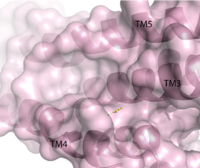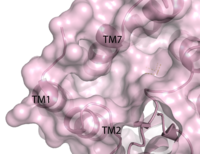Sandbox Reserved 1170
From Proteopedia
(Difference between revisions)
| Line 25: | Line 25: | ||
=== Mechanism of Insulin Secretion === | === Mechanism of Insulin Secretion === | ||
| - | One proposed pathway of insulin secretion by hGPR40 involves the activation of the Gaq/11 protein complex. This complex then activates phospholipase C (PLC) which in turn phosphorylates phosphatidylinositol 4,5-bisphosphate to inositol 1,4,5-triphosphate (IP3) and diacylglycerol (DAG). IP3 can then mediate the influx of | + | One proposed pathway of insulin secretion by hGPR40 involves the activation of the Gaq/11 protein complex. This complex then activates phospholipase C (PLC) which in turn phosphorylates phosphatidylinositol 4,5-bisphosphate to inositol 1,4,5-triphosphate (IP3) and diacylglycerol (DAG). IP3 can then mediate the influx of Ca<sup>2+</sup> caused by the binding of free fatty acids to hGPR40 by moving into the cytoplasm, binding to the endoplasmic reticulum, and allowing for the release of Ca<sup>2+</sup> into the cytosol.<ref name="Burant"/> This increase in [Ca<sup>2+</sup>] amplifies the similar increase in [Ca<sup>2+</sup>] that results from high concentrations of glucose. In this way, hGPR40 mimics glucose dependent insulin secretion.<ref name="Itoh">PMID:12629551</ref> |
Another pathway through which hGPR40 induces insulin expression is through phospholipase D1 (PKD1). When free fatty acids bind to hGPR40, it is able to phosphorylate and therefore activate PKD1. The PKD1 plays a role in controlling the organization of an actin network that lays in role in insulin secretion.<ref name="Burant"/> | Another pathway through which hGPR40 induces insulin expression is through phospholipase D1 (PKD1). When free fatty acids bind to hGPR40, it is able to phosphorylate and therefore activate PKD1. The PKD1 plays a role in controlling the organization of an actin network that lays in role in insulin secretion.<ref name="Burant"/> | ||
Revision as of 13:04, 29 March 2016
Human GPR40, also known as Free Fatty Acid Receptor 1 (FFAR1)
| |||||||||||
References
- ↑ 1.0 1.1 1.2 1.3 Srivastava A, Yano J, Hirozane Y, Kefala G, Gruswitz F, Snell G, Lane W, Ivetac A, Aertgeerts K, Nguyen J, Jennings A, Okada K. High-resolution structure of the human GPR40 receptor bound to allosteric agonist TAK-875. Nature. 2014 Jul 20. doi: 10.1038/nature13494. PMID:25043059 doi:http://dx.doi.org/10.1038/nature13494
- ↑ Kebede M, Ferdaoussi M, Mancini A, Alquier T, Kulkarni RN, Walker MD, Poitout V. Glucose activates free fatty acid receptor 1 gene transcription via phosphatidylinositol-3-kinase-dependent O-GlcNAcylation of pancreas-duodenum homeobox-1. Proc Natl Acad Sci U S A. 2012 Feb 14;109(7):2376-81. doi:, 10.1073/pnas.1114350109. Epub 2012 Jan 30. PMID:22308370 doi:http://dx.doi.org/10.1073/pnas.1114350109
- ↑ Ma Z, Lin DC, Sharma R, Liu J, Zhu L, Li AR, Kohn T, Wang Y, Liu JJ, Bartberger MD, Medina JC, Zhuang R, Li F, Zhang J, Luo J, Wong S, Tonn GR, Houze JB. Discovery of the imidazole-derived GPR40 agonist AM-3189. Bioorg Med Chem Lett. 2016 Jan 1;26(1):15-20. doi: 10.1016/j.bmcl.2015.11.050., Epub 2015 Nov 17. PMID:26620255 doi:http://dx.doi.org/10.1016/j.bmcl.2015.11.050
- ↑ 4.0 4.1 4.2 4.3 4.4 Burant CF. Activation of GPR40 as a therapeutic target for the treatment of type 2 diabetes. Diabetes Care. 2013 Aug;36 Suppl 2:S175-9. doi: 10.2337/dcS13-2037. PMID:23882043 doi:http://dx.doi.org/10.2337/dcS13-2037
- ↑ Sum CS, Tikhonova IG, Neumann S, Engel S, Raaka BM, Costanzi S, Gershengorn MC. Identification of residues important for agonist recognition and activation in GPR40. J Biol Chem. 2007 Oct 5;282(40):29248-55. Epub 2007 Aug 15. PMID:17699519 doi:http://dx.doi.org/10.1074/jbc.M705077200
- ↑ Sum CS, Tikhonova IG, Costanzi S, Gershengorn MC. Two arginine-glutamate ionic locks near the extracellular surface of FFAR1 gate receptor activation. J Biol Chem. 2009 Feb 6;284(6):3529-36. doi: 10.1074/jbc.M806987200. Epub 2008, Dec 8. PMID:19068482 doi:http://dx.doi.org/10.1074/jbc.M806987200
- ↑ Itoh Y, Kawamata Y, Harada M, Kobayashi M, Fujii R, Fukusumi S, Ogi K, Hosoya M, Tanaka Y, Uejima H, Tanaka H, Maruyama M, Satoh R, Okubo S, Kizawa H, Komatsu H, Matsumura F, Noguchi Y, Shinohara T, Hinuma S, Fujisawa Y, Fujino M. Free fatty acids regulate insulin secretion from pancreatic beta cells through GPR40. Nature. 2003 Mar 13;422(6928):173-6. Epub 2003 Feb 23. PMID:12629551 doi:http://dx.doi.org/10.1038/nature01478
- ↑ Kaku K, Enya K, Nakaya R, Ohira T, Matsuno R. Efficacy and safety of fasiglifam (TAK-875), a G protein-coupled receptor 40 agonist, in Japanese patients with type 2 diabetes inadequately controlled by diet and exercise: a randomized, double-blind, placebo-controlled, phase III trial. Diabetes Obes Metab. 2015 Jul;17(7):675-81. doi: 10.1111/dom.12467. Epub 2015 Apr, 23. PMID:25787200 doi:http://dx.doi.org/10.1111/dom.12467



